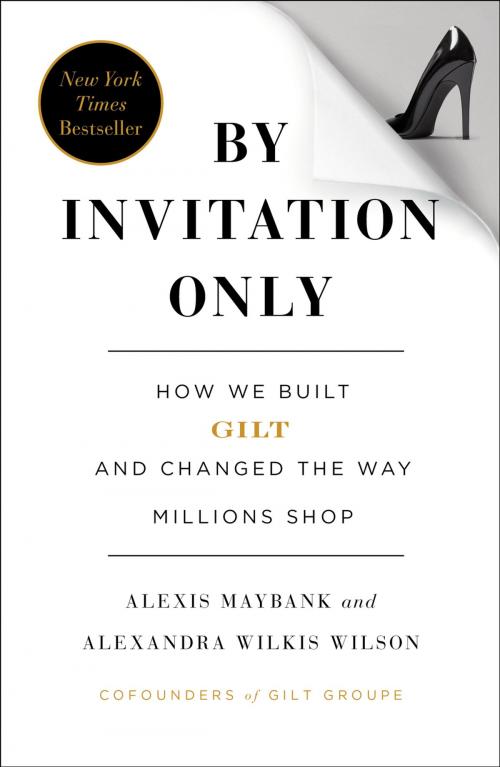By Invitation Only
How We Built Gilt and Changed the Way Millions Shop
Biography & Memoir, Business, Business & Finance, Career Planning & Job Hunting, Entrepreneurship, Entrepreneurship & Small Business| Author: | Alexis Maybank, Alexandra Wilkis Wilson | ISBN: | 9781101571910 |
| Publisher: | Penguin Publishing Group | Publication: | April 12, 2012 |
| Imprint: | Portfolio | Language: | English |
| Author: | Alexis Maybank, Alexandra Wilkis Wilson |
| ISBN: | 9781101571910 |
| Publisher: | Penguin Publishing Group |
| Publication: | April 12, 2012 |
| Imprint: | Portfolio |
| Language: | English |
On a warm September night in 2002, former acquaintances Alexis Maybank and Alexandra Wilkis reconnected at a mixer for new students at Harvard Business School. Alexis had just ended a four-year run at eBay during the dotcom boom and bust. Alexandra had just spent three years as an investment banker at Merrill Lynch. Now they were entering the country’s top training ground for future titans of Wall Street and the Fortune 500.
** **
Little did either suspect that five years later, they’d become famous not in finance or consulting or corporate management, but at the bleeding-edge intersection of fashion and technology.
Gilt Groupe – launched by Alexis, Alexandra, and three colleagues in 2007 – is one of the most fascinating startups of recent years, with a valuation of more than $1 billion. And it all began with one bold idea: to bring sample sales online and change the way millions shop.
As Alexis and Alexandra write about the day Gilt.com went live: “We had created a website that could potentially change the rules of retail, for both shoppers and brands. If shopping was traditionally a slow, leisurely activity that might consume an entire day, it would now be competitive, addictive, urgent, thrilling—a rush delivered at the same time each day. Shopping would become not just easier, but so much fun.”
But turning that vision into reality wasn’t easy. Designers had long controlled their own sample sales by staging them in anonymous, makeshift locations and strictly limiting invitations. Those lucky enough to hear about a Marc Jacobs or Hermès sample sale would drop everything and run for dramatic, fleeting bargains. Why should elite brands support a new startup trying to replicate the experience online?
And even if brands like Valentino, Christian Louboutin, and Zac Posen got on board, would shoppers embrace such a website? Would the kind of people who love high-end fashion really visit a new online sale each day? Was “accessible luxury” a breakthrough idea or an absurd oxymoron?
Alexis and Alexandra share their perspective in this dramatic story of Gilt’s birth, rise, and evolution. They show how they juggled the conflicting needs of their suppliers, engineers, marketers, and potential investors. They explain how they blended their individual strengths and weaknesses and managed their rapidly growing team. They cover the growing pains of expanding into new categories like housewares, travel, and menswear. And they take us through the darkest moments of the recession when Gilt might easily have died.
As you’ll learn from the true story of Gilt, anything is possible for those with the creativity to recognize a new opportunity and the perseverance to make it real.
On a warm September night in 2002, former acquaintances Alexis Maybank and Alexandra Wilkis reconnected at a mixer for new students at Harvard Business School. Alexis had just ended a four-year run at eBay during the dotcom boom and bust. Alexandra had just spent three years as an investment banker at Merrill Lynch. Now they were entering the country’s top training ground for future titans of Wall Street and the Fortune 500.
** **
Little did either suspect that five years later, they’d become famous not in finance or consulting or corporate management, but at the bleeding-edge intersection of fashion and technology.
Gilt Groupe – launched by Alexis, Alexandra, and three colleagues in 2007 – is one of the most fascinating startups of recent years, with a valuation of more than $1 billion. And it all began with one bold idea: to bring sample sales online and change the way millions shop.
As Alexis and Alexandra write about the day Gilt.com went live: “We had created a website that could potentially change the rules of retail, for both shoppers and brands. If shopping was traditionally a slow, leisurely activity that might consume an entire day, it would now be competitive, addictive, urgent, thrilling—a rush delivered at the same time each day. Shopping would become not just easier, but so much fun.”
But turning that vision into reality wasn’t easy. Designers had long controlled their own sample sales by staging them in anonymous, makeshift locations and strictly limiting invitations. Those lucky enough to hear about a Marc Jacobs or Hermès sample sale would drop everything and run for dramatic, fleeting bargains. Why should elite brands support a new startup trying to replicate the experience online?
And even if brands like Valentino, Christian Louboutin, and Zac Posen got on board, would shoppers embrace such a website? Would the kind of people who love high-end fashion really visit a new online sale each day? Was “accessible luxury” a breakthrough idea or an absurd oxymoron?
Alexis and Alexandra share their perspective in this dramatic story of Gilt’s birth, rise, and evolution. They show how they juggled the conflicting needs of their suppliers, engineers, marketers, and potential investors. They explain how they blended their individual strengths and weaknesses and managed their rapidly growing team. They cover the growing pains of expanding into new categories like housewares, travel, and menswear. And they take us through the darkest moments of the recession when Gilt might easily have died.
As you’ll learn from the true story of Gilt, anything is possible for those with the creativity to recognize a new opportunity and the perseverance to make it real.















